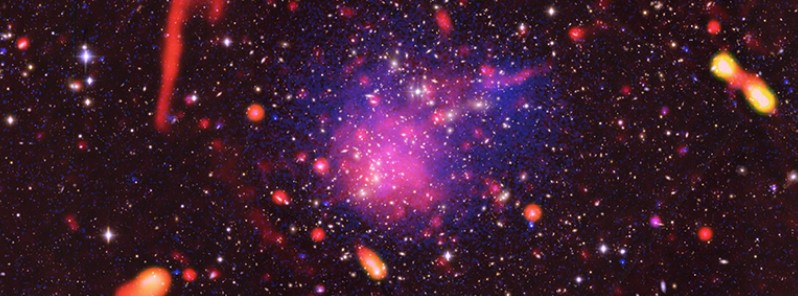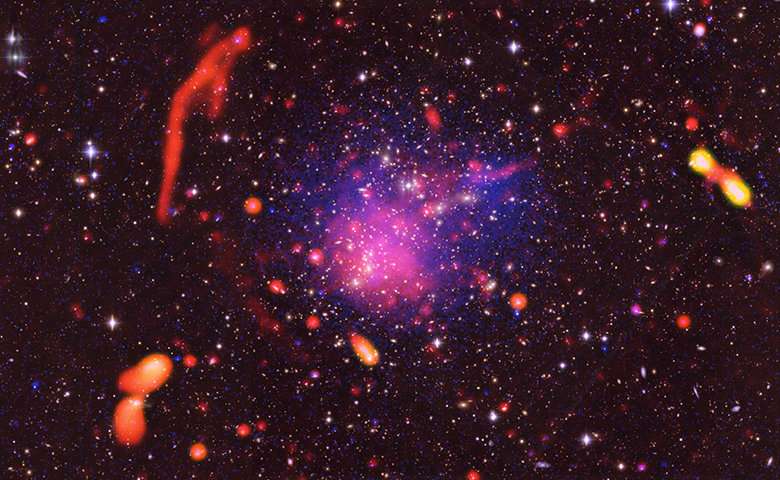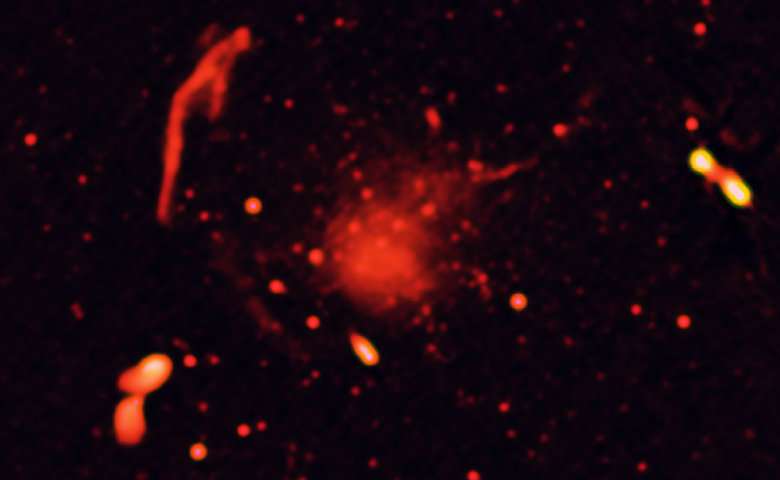Galaxy-cluster collisions set off celestial fireworks display

A giant collision of several galaxy clusters, each containing hundreds of galaxies, has produced this spectacular panorama of shocks and energy. The collisions generated shock waves that set off a celestial fireworks display of bright radio emission, seen as red and orange. In the center of the image, the purple indicates X-rays caused by extreme heating.
The region is collectively known as Abell 2744, some 4 billion light-years from Earth. The radio portion of the image comes from new observations made with the National Science Foundation's Karl G. Jansky Very Large Array (VLA), and is combined with earlier data from NASA's Chandra X-ray Observatory. Both are overlaid on an image at visible-light wavelengths made with data from the Subaru telescope and the Very Large Telescope (VLT). The new VLA observations revealed previously undetected regions where shocks accelerated subatomic particles, causing radio emission.

Composite image of Abell 2744 region, with radio, X-Ray, and optical (visible light) data combined.Credit: Pearce et al.; Bill Saxton, NRAO/AUI/NSF; Chandra, Subaru; ESO.

Radio-only image of Abell 2744 region, showing radio-emitting features caused by subatomic particles accelerated to high speeds by the collisions of giant clusters of galaxies. Credit: Pearce et al., NRAO/AUI/NSF
Astronomers are studying the combined image in an attempt to decipher the sequence of galaxy-cluster collisions. Currently, they said, evidence indicates a North-South (top-bottom in the image) collision of subclusters and an East-West (left-right in the image) collision. There is a possible third collision, and the astronomers continue to analyze their data to uncover more details about the region's complex history of collisions and their aftermath.
Animated GIF cycles through the individual images (radio, X-ray, optical) of Abell 2744. Credit: Pearce et al.; Bill Saxton, NRAO/AUI/NSF; Chandra; Subaru; ESO.
The scientists reported their findings in a paper in the Astrophysical Journal by Connor Pearce, of the Harvard-Smithsonian Center for Astrophysics and the University of Southampton in the UK, and an international team of colleagues.
Provided by National Radio Astronomy Observatory
Featured image: Composite image of Abell 2744 region, with radio, X-Ray, and optical (visible light) data combined. Credit: Pearce et al.; Bill Saxton, NRAO/AUI/NSF; Chandra, Subaru; ESO.

According to scientists, this happened 4 billion years ago, and several clusters of galaxies with several dozen galaxies in clusters took part in the collision. Can researchers answer you: how long do these crashes last from the beginning to the end? Are those experts sure that they have now seen this event that started exactly 4 billion years ago and how did they know that they would see it at this time?
Especially the question is how can we see this fireworks at such a distance, as if none of that light has passed past and beyond those telescopes?
If such a bunch of galaxies can stand on such a distance as a square of a square meter, then what is the universe if our telescope would be the surface, say, half of our Earth’s half-globe?
If this can be believed, then we, human beings, are something that goes beyond the powers of the universe.